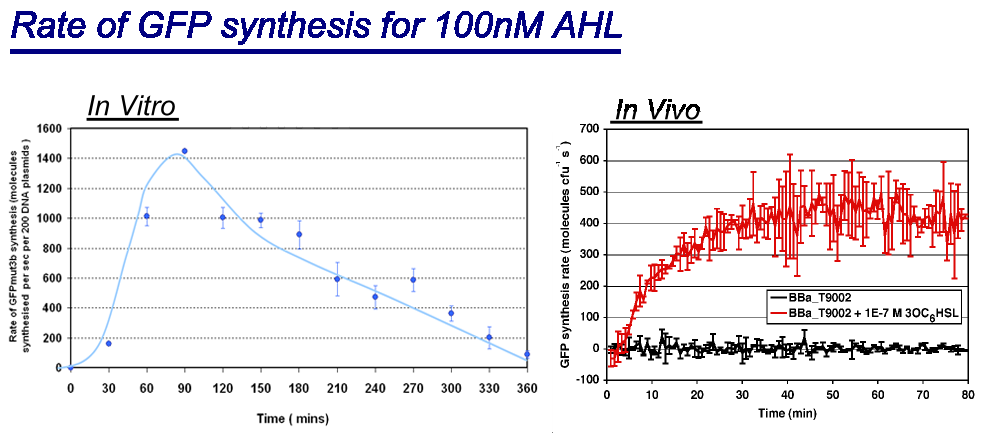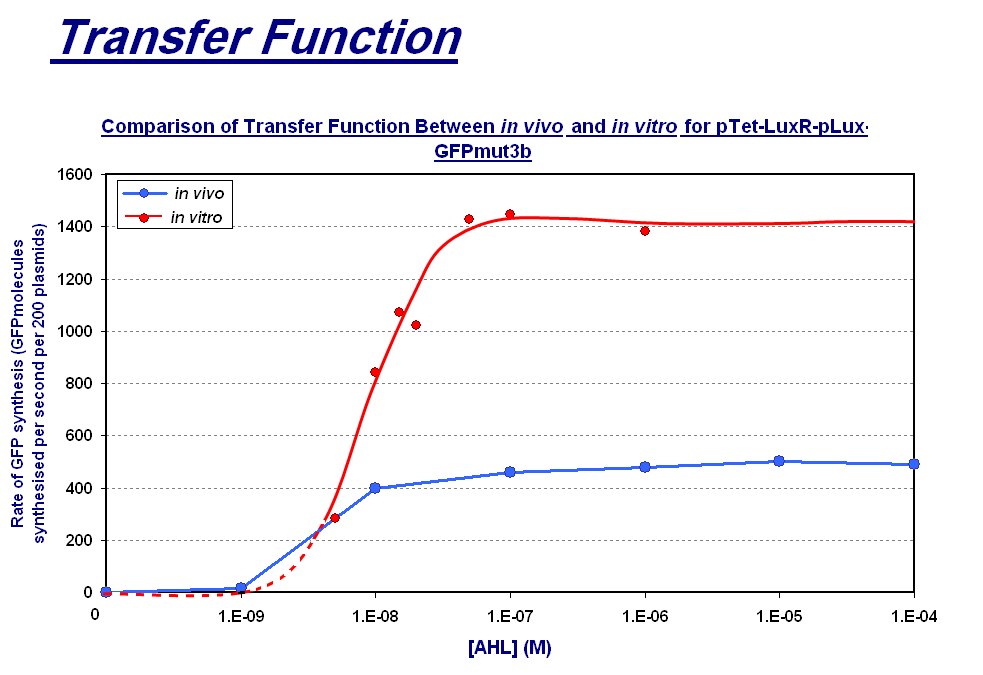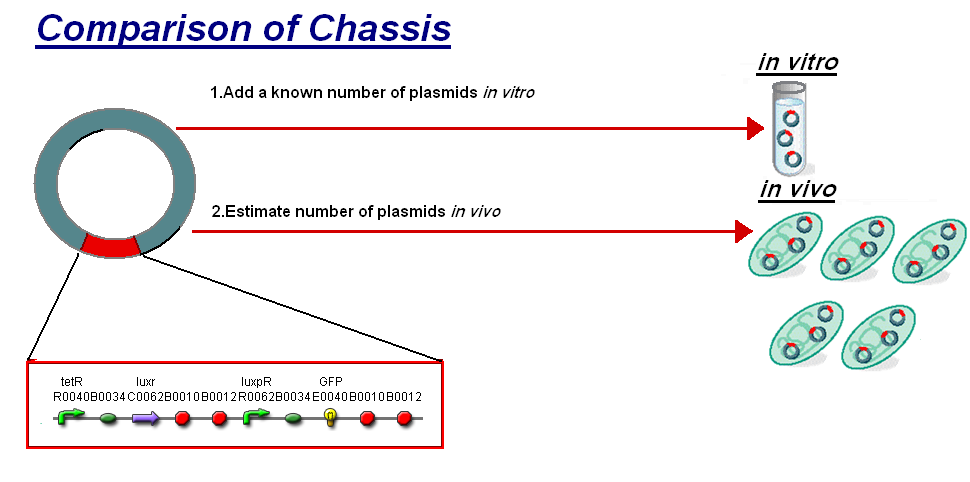Imperial/Infector Detector/F2620 Comparison
From 2007.igem.org
(→Summary of Comparison) |
m (→Summary of Comparison) |
||
| Line 44: | Line 44: | ||
#'''Transfer Function'''- [AHL] vs rate of GFP synthesis | #'''Transfer Function'''- [AHL] vs rate of GFP synthesis | ||
|} | |} | ||
| - | + | |} | |
<br clear=all> | <br clear=all> | ||
{|align="center" style="width:800px; text-align: center; border-top:2px solid #000077; border-right:2px solid #000077; border-bottom:2px solid #000077; border-left:2px solid #000077;" | {|align="center" style="width:800px; text-align: center; border-top:2px solid #000077; border-right:2px solid #000077; border-bottom:2px solid #000077; border-left:2px solid #000077;" | ||
| Line 52: | Line 52: | ||
<br> | <br> | ||
The graph shows the following: | The graph shows the following: | ||
| - | *''in vivo'' has a '''maximal rate of 400-500 molecules of GFP synthesised per second per cell'''. In addition the rate reaches a steady state after | + | *''in vivo'' has a '''maximal rate of 400-500 molecules of GFP synthesised per second per cell'''. In addition the rate reaches a steady state after 30minutes.<br> |
| - | *''in vitro'' has the equivalent of '''1400 molecules of GFP synthesised per second per | + | *''in vitro'' has the equivalent of '''1400 molecules of GFP synthesised per second per 200 plasmids'''. Interestingly the ''in vitro'' chassis does not reach a steady state, in fact it decreases in rate of synthesis after 90 minutes and keeps decreasing until rate is zero at around 360 minutes. This is thought to be because the ''in vitro'' chassis runs out of energy after 90 minutes, because of this rate slowly decreases. |
<span style="font-size:120%;">'''Key Difference:'''</span> | <span style="font-size:120%;">'''Key Difference:'''</span> | ||
*GFP Synthesis - The life of synthesis of ''in vitro'' is about 90 minutes, compared to ''in vivo'' that has a life span of days. The differences is that ''in vitro'' has a burst of expression giving a high but short rate of GFP synthesis. ''In vivo'' is a slower rate but more prolonged rate of synthesis. | *GFP Synthesis - The life of synthesis of ''in vitro'' is about 90 minutes, compared to ''in vivo'' that has a life span of days. The differences is that ''in vitro'' has a burst of expression giving a high but short rate of GFP synthesis. ''In vivo'' is a slower rate but more prolonged rate of synthesis. | ||
| - | * | + | *Initial Rate of Synthesis - The initial rate of GFP synthesis is slower for ''in vitro''. This is thought to be due to LuxR levels, which in''in vivo'' are at steady state but for ''in vitro'' has to produce the LuxR upon addition of DNA. |
Interestingly the values of rate of synthesis are in the same order magnitude of hundreds, this suggesting that the normalisation we are using to compare these chassis is valid. | Interestingly the values of rate of synthesis are in the same order magnitude of hundreds, this suggesting that the normalisation we are using to compare these chassis is valid. | ||
|} | |} | ||
Revision as of 00:23, 27 October 2007

Summary of Comparison
We thought to compare our in vitro characterisation to the characterisation of [http://partsregistry.org/Part:BBa_F2620 F2620] in vivo with the aim to highlight some of the differences between the chassis and investigate how the construct's characteristics may change between them. The [http://partsregistry.org/Part:BBa_F2620 F2620] is an ideal construct for comparison because of its detailed characterisation in vivo. The construct is the same as the construct 1 that was used for infecter detector, pTet-LuxR-pLux-GFPmut3b.
The key results of the comparison were:
- The creation of a new unit to allow comparison between in vitro and in vivo chassis.
- The response of the construct in E.coli chassis in vivo and in vitro is independent of the chassis.
These are exciting findings, revealing the potential for the exploration of new chassis and the ability to use constructs in an exchangeable manner.
 |
| Comparison between in vivo and in vitro for rate of GFPmut3b synthesis for 100nM AHL. The in vivo chassis used was the bacterial strain MG1655 and the in vitro chassis was Promega Commercial S30 Cell Extract(60µl)
Key Difference:
Interestingly the values of rate of synthesis are in the same order magnitude of hundreds, this suggesting that the normalisation we are using to compare these chassis is valid. |
 |
The graph above shows the transfer function of [AHL] input vs rate of GFP synthesis output. The graph shows the follwoing:
|
